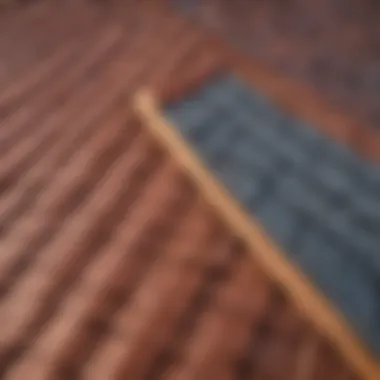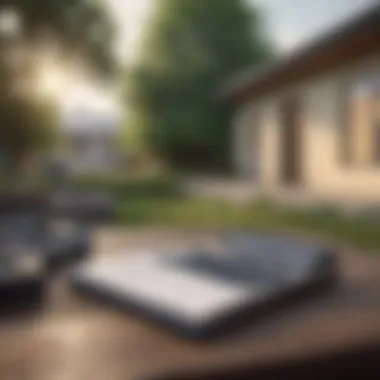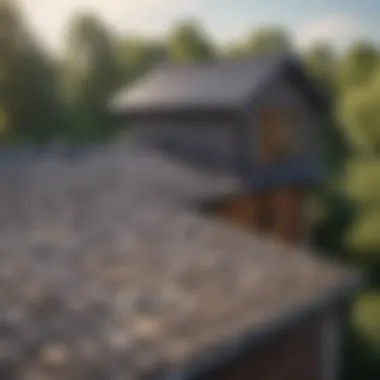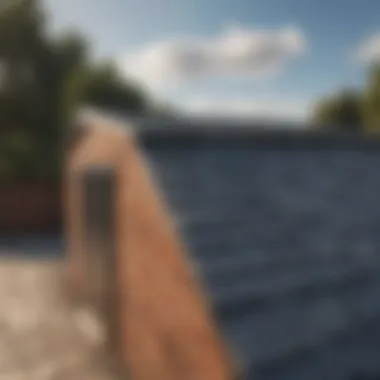Understanding Shed Roof Replacement Costs Efficiently


Intro
Shed roof replacement is a significant project for many homeowners and business owners. The cost of replacing a shed roof can vary widely depending on several factors. Understanding these factors can lead to better financial planning and decision-making. This article will delve into the complexities of shed roof replacement costs, examining both the materials required and the labor involved. Additionally, we will highlight how regional pricing differences can impact overall expenses.
As we explore this subject, it will be crucial to examine the coverage options available to protect your investment. Many people overlook the risk and exposure that comes with such projects. Informed choices can save you time and money in the long run.
Let's move to the specific considerations regarding insurance coverage, which is vital for reducing financial burdens when incidents arise.
Foreword to Shed Roof Replacements
Shed roof replacements are an essential consideration for homeowners and business owners alike. A shed roof is a single-sloped roof structure, commonly used for storage buildings, workshops, or garden sheds. Understanding the nuances of replacing a shed roof has significant implications on cost management and long-term property maintenance. In an era where every financial decision counts, navigating through the complexity of shed roof replacement costs can empower owners to make informed choices.
What is a Shed Roof?
A shed roof is characterized by its simple, sloping design, typically featuring one continuous plane that extends from one wall to another. This design is not only cost-effective but also uncomplicated when it comes to construction and maintenance. Shed roofs are often favored for their aesthetic appeal in specific architectural styles, such as modern or minimalist designs. Moreover, the single slope aids in efficient water drainage, reducing the risk of pooling and subsequent roof damage. Understanding the basic structure and function of shed roofs sets a solid foundation for discussing the necessary considerations for their replacement.
Importance of Roof Condition
The condition of a roof is paramount to the overall integrity of a property. A deteriorating roof can lead to numerous issues, including water leaks, mold growth, and structural weakening. Regular assessments of roof condition can highlight potential problems before they escalate into major repairs or replacements. Roofing materials have varying lifespans, and factors such as weather, maintenance practices, and installation quality significantly impact longevity. Homeowners must prioritize roof health not only for immediate cost savings but also for maintaining property value over time. Closely monitoring the condition of a shed roof can inform when replacement is necessary, ultimately saving time and money in the long run.
Factors Influencing Replacement Costs
Understanding the costs involved in replacing a shed roof is essential for homeowners and business owners alike. Various factors can significantly impact these costs. Being informed about material choices, labor costs, regional differences, as well as the roof’s size and complexity is vital. Each of these elements contributes to the overall price, and making decisions based on them can bring financial advantages. This section elaborates on the different factors at play, providing a comprehensive view of what influences the replacement costs of a shed roof.
Material Choices
Material selection is one of the most influential factors affecting replacement costs. Different materials come with varying prices not just for the materials themselves, but also for installation and long-term maintenance needs. Each choice has its benefits and drawbacks. Here, we will explore options including asphalt shingles, metal roofing, wooden shakes, and rubber roofing.
Asphalt Shingles
Asphalt shingles are one of the most common roofing materials. They are cost-effective and widely available. This material offers a good balance between initial price and lifespan. The popularity of asphalt shingles lies in their versatility and ease of installation. However, one must note that they may not hold up as well in extreme weather conditions compared to other materials.
Advantages:
- Lower initial costs
- Straightforward installation
- Variety of styles and colors
Disadvantages:
- Shorter lifespan compared to metal roofing
- Vulnerability to harsh weather
Metal Roofing
Metal roofing is gaining traction for shed roofs. It is known for its durability and longevity. This material may involve a higher upfront cost but often pays off through reduced maintenance and energy efficiency over time. Metal roofs can withstand harsh conditions and tend to reflect heat, leading to potential savings on energy bills.
Advantages:
- Long-lasting and durable
- Energy-efficient
- Resistant to extreme weather
Disadvantages:
- Higher initial costs
- May require professional installation
Wooden Shakes
Wooden shakes offer an aesthetic appeal that is hard to match. They are often chosen for their natural look and can enhance the value of a property. However, wooden shakes come with maintenance needs that can increase the long-term costs. Depending on the type of wood used, the longevity can also vary.
Advantages:
- Unique and natural appearance
- Good insulating properties
Disadvantages:
- Higher maintenance needs
- Vulnerable to pests and rot
Rubber Roofing
Rubber roofing is typically used for flat or low-slope roofs. It is praised for its waterproof qualities and ease of installation. This material can also be a sustainable choice since it often comes from recycled materials. Despite its specialized use, the costs can vary based on the type of rubber product chosen.
Advantages:


- Excellent waterproofing properties
- Eco-friendly options available
Disadvantages:
- Limited aesthetic appeal
- May need replacement sooner than expected in some cases
Labor Costs
Labor costs vary based on several aspects: local market rates, project complexity, and the experience level of the contractors. Understanding how these factors influence wages is crucial for budgeting appropriately.
Hourly Rates
Labor costs are often charged by the hour. Rates may differ significantly depending on where you are located and the current market demands. In urban areas, for example, hourly labor rates are typically higher compared to rural locations.
Consideration: The key here is to obtain several quotes to assess the average rates in your area.
Project Complexity
The complexity of a roofing project can greatly influence labor costs. More challenging projects may require skilled labor and additional time. A straightforward job will naturally incur lower labor charges.
Key Point: Always discuss the complexity with your contractor to avoid surprises in costs later.
Experience Level
The experience level of the contractor plays an important role in cost. Highly experienced contractors may charge more, but they often offer superior workmanship. It may be worthwhile to weigh the cost against the potential long-term benefits of quality installation.
Geographical Variations
Location does not only affect material costs but also labor rates and regulations. Understanding geographical variations in costs can help in effective budgeting for the project.
Urban vs Rural Areas
Costs can differ greatly between urban and rural areas. Urban settings usually have higher demand for roofing services, leading to inflated labor costs. Meanwhile, rural areas may provide more affordable options but might have limited availability of skilled labor.
Key Insight: Assess the local market to determine the best approach for your specific location.
Local Building Codes
Local building codes can influence both material choices and installation techniques. Compliance with these codes is often mandatory and can add to overall costs. Understanding these requirements upfront can prevent unexpected expenses.
Important Note: Check with local authorities to understand specific regulations that might affect your project.
Size and Complexity of the Roof
The size and design features of the roof are crucial considerations. Larger and more complex roofs can translate into higher costs due to the increased amount of materials and labor involved.
Shed Dimensions
The overall dimensions of the shed play a significant role in determining the total cost. Larger structures will naturally require more materials and labor, thus increasing expenses.
Consideration: Ensure accurate measurements to avoid surprises in your cost estimates.
Design Features
Special design features such as skylights, overhangs, or unique shapes can complexity to the project. These features can enhance the aesthetic of the shed but will also raise the cost of materials and labor.
Key Point: Discuss any design plans with your contractor to understand how they impact the overall budget.
Understanding these factors can significantly aid in managing the budget for a shed roof replacement. By taking into consideration material options, labor costs, geographical influences, and roof dimensions, homeowners can make informed decisions.
Average Shed Roof Replacement Costs
Understanding the average costs associated with shed roof replacement is crucial for homeowners and business owners alike. This section breaks down the financial landscape surrounding shed roofing projects, making it clear what to expect in terms of expense. Knowing the costs can help you budget effectively and make informed decisions, ultimately saving you from unexpected financial burdens.
Cost Estimates by Material
When it comes to shed roof replacement, the choice of material plays a significant role in determining costs. Here is a breakdown of popular roofing materials:
- Asphalt Shingles: These are the most common choice for roofing due to their affordability and ease of installation. The average cost for material and labor ranges from $3 to $5 per square foot.
- Metal Roofing: Known for its durability and resistance to various weather conditions, metal roofing averages between $6 and $12 per square foot. It can be a more costly upfront investment, yet is valued for its longevity.
- Wooden Shakes: This material provides unique aesthetic appeal but can be expensive, averaging about $9 to $15 per square foot. Maintenance is required to preserve quality.
- Rubber Roofing: Often used for flat roofs or low-sloped designs, the cost may vary from $4 to $8 per square foot depending on the quality and thickness of the rubber material.


"Choosing the right material impacts not only initial costs but also long-term maintenance expenses."
Comparative Analysis with Traditional Roofing
It's imperative to evaluate how shed roof replacement costs compare to traditional roofing systems. Traditional roofs often utilize materials like asphalt shingles or tiles, which can have varying costs similar to those mentioned earlier. However, several factors may differentiate shed roofing from conventional roofs:
- Installation Complexity: Shed roofs typically have a simpler design, which can lead to reduced labor costs compared to intricate traditional roofs.
- Material Longevity: Depending on the selected material, a shed roof might require replacement less frequently, affecting long-term financial considerations.
- Architectural Styles: Traditional roofs often need to accommodate specific styles and building regulations. In contrast, shed roofs provide flexibility in design, which can lead to cost savings.
When comparing costs, it is essential to factor in both immediate expenses and long-term implications, including maintenance, potential repairs, and the lifespan of the roof.
Being informed about average costs associated with shed roof replacement enables better decision-making processes regarding roofing projects, ensuring that homeowners and business owners can effectively manage their financial investments.
Insurance Considerations
Understanding the insurance implications of a shed roof replacement is crucial for homeowners and business owners. Insurance can act as a safety net during unexpected damage and assist in mitigating the costs associated with roof repairs or complete replacement. Recognizing what your insurance encompasses can prevent unforeseen expenses and give clarity on your financial responsibilities during a roofing project.
Understanding Coverage Types
Homeowner's Insurance
Homeowner's insurance is often the primary financial resource when considering a roof replacement. This type of insurance generally covers damage to the home and certain structures, including roofs, caused by specific peril like storms, fires, or vandalism. A fundamental characteristic of homeowner's insurance is its comprehensive nature. It usually includes coverage for damages up to a certain limit without any additional premium.
The appeal of homeowner's insurance is its versatility. Most policies cover typical wear and tear, although limits might apply depending on individual policies. However, a unique feature of homeowner's insurance is the deductible you must pay before your coverage kicks in. This could be a disadvantage if the deductible exceeds repair costs, prompting the homeowner to cover expenses out-of-pocket. For many individuals, this type of insurance stands as a practical option for addressing major expenses related to roof replacement.
Specific Policy Add-Ons
Specific policy add-ons can enhance or customize your insurance coverage. These add-ons may include options for increased roof replacement coverage or coverage for particular materials. A key characteristic of these options is their ability to cater to individual needs. For instance, you might want to ensure that your roof replacement is covered under replacement cost coverage instead of actual cash value.
The advantage of specific policy add-ons is flexibility. They enable homeowners to tailor their coverage based on the material used for their roofs or their financial situation. However, they often come at an additional premium, and not every add-on is necessary for every homeowner. Evaluating your needs before purchasing these add-ons can optimize your insurance strategy for roof replacement.
Making a Claim for Roof Replacement
Making a claim for roof replacement can seem daunting but is manageable with right preparation. First, documenting the roof's condition before damage occurs is essential. This documentation serves as evidence for your insurance claim. When filing a claim, it's important to ensure that damage is clearly visible and falls within the scope of your coverage.
Following your insurance company's procedures is vital. Often, this means contacting your agent to initiate the claim process. Keep records of all communications and inspections. It’s also wise to have a contractor’s estimate ready to provide your insurer with detailed repair costs.
"Thorough documentation and clear communication with your insurance provider can significantly streamline the claims process."
In summary, understanding insurance coverage related to a shed roof replacement is pivotal. Homeowner's insurance offers a foundational safety net, while specific add-ons allow for customization. Effective claim-making relies on solid documentation and methodical communication. Navigating these considerations can substantively impact your financial planning for roof replacement.
Long-Term Financial Planning
Long-term financial planning is crucial when considering a shed roof replacement. This process lays the groundwork for making informed decisions about expenses and overall budgeting. Understanding the financial implications can guide homeowners and business owners to anticipate potential costs and challenges over time. Proper planning can also improve one’s ability to respond to unexpected issues, ensuring that funds are available when necessary.
One primary aspect of long-term financial planning is establishing a clear budget. This budget should incorporate not just the immediate costs of replacement, but also future maintenance and repair expenses. An in-depth review of these factors can lead to better financial health over time, reducing the likelihood of future financial strain.
It’s also important to consider the return on investment (ROI) that comes with a new roof. A well-maintained roof can add significant value to a property. Thus, investing in quality materials and professional labor may prove beneficial in the long run. Potential buyers often look at the roof's condition when assessing a property’s overall value, making it a key fixture in real estate transactions.
To summarize, the benefits of long-term financial planning for shed roof replacement include:
- Reducing Future Financial Burdens: Anticipating costs helps avoid surprises.
- Boosting Property Value: Quality materials and workmanship can enhance the overall worth of your property.
- Facilitating Maintenance: Planning aids in budgeting for future upkeep, reducing long-term costs.
"Effective financial planning mitigates unexpected costs, providing peace of mind as you navigate roof replacement."
By focusing on these elements, individuals can ensure that they are prepared for both the short-term and long-term ramifications of their roofing decisions.
Budgeting for Roof Replacement
Budgeting for roof replacement involves several steps that help in maintaining financial control throughout the process. Start by evaluating your current roof’s condition and determining if a replacement is genuinely needed. Gathering estimates from various contractors can also give a clearer picture of what to expect regarding costs.
Here are some crucial aspects to consider when budgeting:
- Material Costs: Different roofing materials come with varying price ranges. Researching material options like metal roofing, asphalt shingles, or rubber roofing will provide insights into the potential expenses.
- Labor Costs: Labor is often a significant component of the total cost. Factors influencing labor charges include the skill level of the workforce and the complexity of the project.
- Permits and Inspections: Depending on your location, you may need permits or inspections, which can bring additional costs.
- Contingency Fund: Setting aside a portion of the budget for unexpected challenges is wise. Aim for around 10-15% of the total budget to account for any surprises that may arise during the project.
Overall, a well-structured budget can lessen the burden of spending and contribute to a smooth replacement process.
Cost vs. Value of Maintenance
Considering the cost versus the value of maintenance is vital when planning for a shed roof replacement. Regular upkeep can extend the life of your roof, thereby maximizing your investment. It is essential to identify maintenance tasks that are necessary and how often they must be performed.


There are several benefits to prioritizing maintenance:
- Preventing Major Repairs: Small issues can be identified and addressed early, preventing them from escalating into costly repairs.
- Maintaining Efficiency: A well-maintained roof can improve energy efficiency, which may reduce heating and cooling costs over time.
- Enhancing Longevity: Investing in regular maintenance can extend the roof's lifespan, ensuring that you avoid premature replacement.
In contrast, neglecting maintenance can lead to significant expenses down the line. Homeowners should assess the long-term value maintenance brings in comparison to its costs. It can be tempting to overlook seemingly minor issues; however, these often snowball into larger, more expensive problems. Therefore, evaluating maintenance in the context of roof replacement costs adds clarity to what initially seems like separate financial issues.
Understanding the interplay between maintenance costs and the value it provides can support informed financial decisions regarding shed roof replacement.
How to Prepare for Roof Replacement
Preparing for roof replacement is a critical step for homeowners and business owners alike. This phase not only sets the tone for the replacement process but also ensures that all aspects are considered, leading to a smoother experience. A well-prepared owner can avoid surprises and manage costs effectively, leading to a successful project completion.
Selecting a Contractor
Reviewing Credentials
Reviewing the credentials of potential contractors is essential. The aim is to hire a qualified professional who has the necessary licenses and is insured. One key aspect of this process involves checking for certifications. Such credentials demonstrate that the contractor understands current standards and best practices. It is a beneficial choice for homeowners to focus on contractors with positive reviews and recommendations.
When you consider credentials, a unique feature is that many roofing contractors provide a portfolio of completed projects. This portfolio can offer insights into their style, reliability, and range of experience. However, some homeowners may feel overwhelmed by the amount of information available. Therefore, critical assessment is necessary, as poorly reviewed contractors might lead to subpar results.
Getting Multiple Quotes
Getting multiple quotes is another important step in the preparation process. This approach allows homeowners to evaluate offers from various contractors, helping them understand market rates. A key characteristic of this strategy is comparison. By comparing quotes, homeowners can discern which contractor offers the best value for their budget.
A notable unique feature of obtaining multiple quotes is the opportunity to negotiate. Homeowners can leverage the information gathered to ask for better pricing or packages. However, one disadvantage is that this process can be time-consuming. It can also generate confusion if the quotes vary widely in scope and price. To minimize this issue, it is essential to ensure that all quotes include similar work specifications.
Understanding the Timeline
Understanding the timeline of a roof replacement is vital for effective planning. Homeowners should inquire about the estimated duration of the project during contractor discussions. A clear timeline allows for better coordination with personal schedules and potential disruptions.
Several factors influence the timeline. Weather conditions, the size of the roof, and material choices can all alter the expected completion date. Homeowners must prepare for contingencies, as delays can happen. Thus, discussing the timeline upfront is beneficial and fosters transparency between the homeowner and the contractor. This understanding ultimately equips the homeowner to manage expectations and enhance communication throughout the process.
Post-Replacement Considerations
When a shed roof replacement is finished, the associated considerations extend beyond just the installation. These post-replacement actions are crucial for maintaining the longevity and effectiveness of the new roof. Addressing these factors can help prevent future expenses, ensure safety, and enhance the overall value of the property.
Maintenance Tips
Regular maintenance serves as the backbone of a reliable and functional shed roof. Homeowners should incorporate a routine check-up schedule to mitigate any potential issues. Here are some key tips:
- Inspect Regularly: Check the roof for signs of wear or damage, such as cracked shingles or rust.
- Clean Gutters: Ensure gutters are clear of debris to prevent water from pooling or overflowing.
- Trim Overhanging Branches: Limiting tree growth near the roof minimizes the likelihood of branches falling and causing damage.
- Immediate Repairs: Address any issues promptly to avoid short-term problems becoming long-term issues.
These steps help to extend the lifespan of the roof and reduce the likelihood of significant repair costs.
Insurance Policy Review
After a roof replacement, it’s essential to take a few moments to review your insurance policy. This simple action can save homeowners from unforeseen financial challenges. Consider the following:
- Understanding Coverage: Ensure you know what your current homeowner's policy covers specifically for roof replacement. This includes checking if it covers wear and tear or only sudden damage.
- Policy Updates: Update your insurance to reflect the new roof's value. This is also necessary in case of future claims.
- Consider Add-Ons: Some insurers provide options for add-ons that cover specific types of damage. Explore these if applicable.
“Regularly reviewing your insurance can save you from financial surprises later on.”
Epilogue
In this article, we delved into various aspects of shed roof replacement, focusing on costs, materials, and planning considerations. Understanding the journey of replacing a shed roof is crucial not only for budgeting but also for ensuring long-lasting effectiveness.
Importance of Cost Awareness
Cost awareness is pivotal. Homeowners and business owners must recognize that replacement costs depend on multiple factors. These include the material chosen, labor fees, and geographical influences. Each element plays a role in budgeting effectively for this endeavor.
Benefits of Planning
Planning ahead has benefits. By identifying and understanding potential costs, individuals can avoid financial strain. Setting a reasonable budget allows for better decision-making when it comes to materials and labor. This way, the investment translates to durability and performance of the roof, meeting the expected lifespan and reducing future repair needs.
"A well-planned project saves both time and money, leading to a more satisfactory outcome for all stakeholders."
Considerations for Maintenance
Post-replacement, maintenance cannot be overlooked. Regular inspections and care are essential for maximizing longevity. Homeowners should ensure they understand maintenance strategies, as these will influence the overall costs in the long-term. An effective maintenance routine can reveal small issues before they become major problems, ultimately safeguarding their investment.
Final Thoughts
The process of replacing a shed roof encompasses more than just the act itself; it's about strategic planning, financial consideration, and in-depth maintenance knowledge. With the right insights and approaches, individuals can ensure that their roofs perform well for years to come.
This conclusion brings together the key insights presented in the article and reinforces the necessity of a methodical approach to shed roof replacements.



